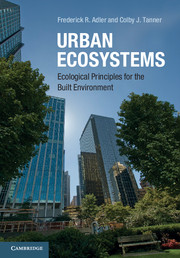5 - Implications of urban ecology
Published online by Cambridge University Press: 05 May 2013
Summary
Cities probably arose when people clustered together for protection and for food. These clusters, however, began to change human needs almost as soon as they came into existence. New forms of government, society, and transportation developed, and with them the beginnings of the infrastructure that defines modern urban areas. Human population regulation no longer fit the ecological top-down or bottom-up models, but resulted from complex social, political, and economic forces rather than local availability of food or other resources.
This book has explored how this transformation of human ecology changes the functioning of the ecosystem and the structure of the ecological communities that coexist with people in the built environment. Those changes are profound, reaching from the way that molecules move and are processed to the way that populations interact and organisms evolve, with most being unintended consequences of human activities designed for other purposes and goals.
This chapter outlines some of the implications of these unintended consequences from the human perspective. First, human residents of urban areas, much like the other organisms that live there, experience new stresses. The first section focuses on the health effects of urban living on humans that often parallel the effects on other animals. These health effects are part of a much larger range of effects on humans that play a considerable role in determining the quality of life within cities, including access to cultural and social resources, aesthetics, safety, and equality.
- Type
- Chapter
- Information
- Urban EcosystemsEcological Principles for the Built Environment, pp. 253 - 290Publisher: Cambridge University PressPrint publication year: 2013



